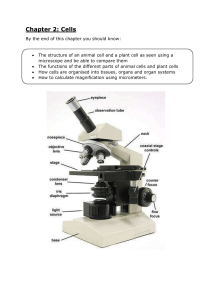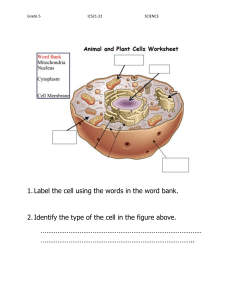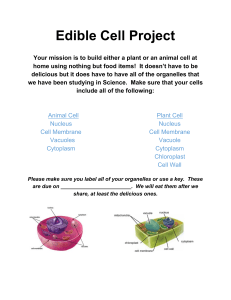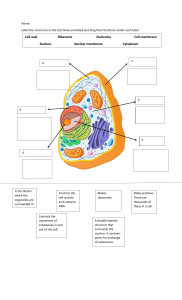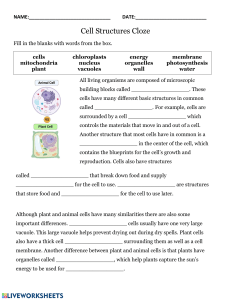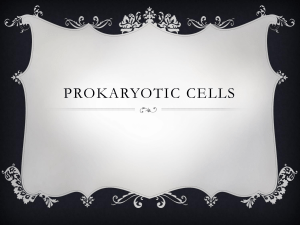Cell and Transport Exams with Answer Key- Somaliland Biology Exams - Ombiology Books - Ahmed Omaar
advertisement
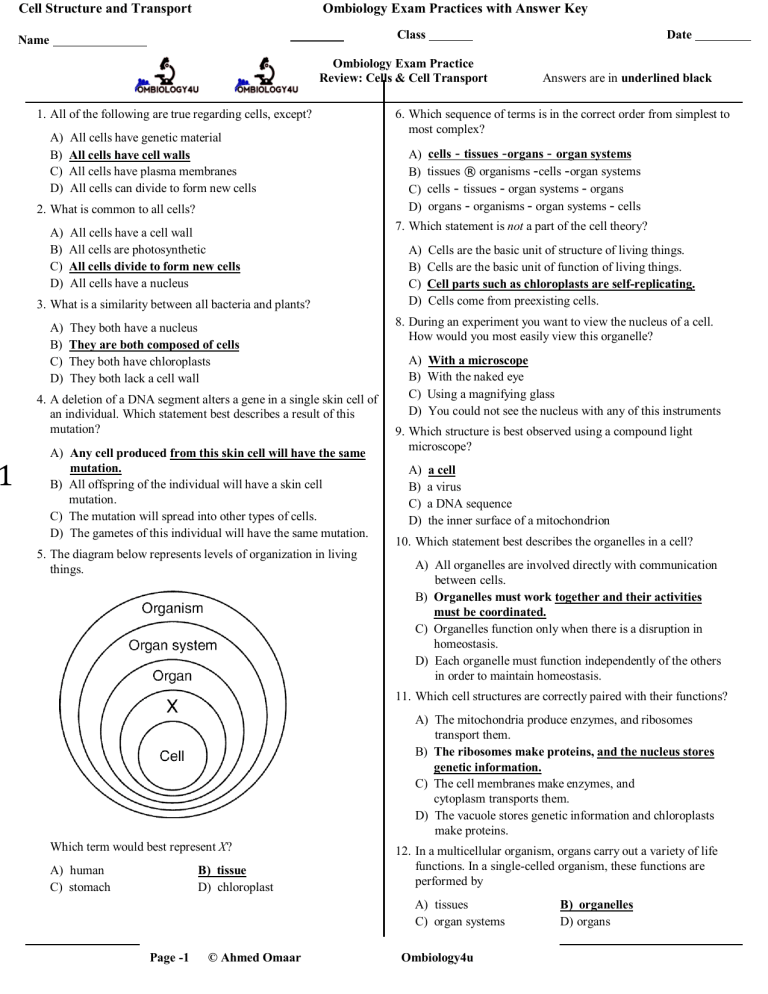
1 Cell Structure and Transport Ombiology Exam Practices with Answer Key Class Name Date Ombiology Exam Practice Review: Cells & Cell Transport 1. All of the following are true regarding cells, except? A) B) C) D) All cells have genetic material All cells have cell walls All cells have plasma membranes All cells can divide to form new cells 2. What is common to all cells? A) B) C) D) All cells have a cell wall All cells are photosynthetic All cells divide to form new cells All cells have a nucleus 3. What is a similarity between all bacteria and plants? A) B) C) D) They both have a nucleus They are both composed of cells They both have chloroplasts They both lack a cell wall 4. A deletion of a DNA segment alters a gene in a single skin cell of an individual. Which statement best describes a result of this mutation? A) Any cell produced from this skin cell will have the same mutation. B) All offspring of the individual will have a skin cell mutation. C) The mutation will spread into other types of cells. D) The gametes of this individual will have the same mutation. 5. The diagram below represents levels of organization in living things. Answers are in underlined black 6. Which sequence of terms is in the correct order from simplest to most complex? A) B) C) D) cells - tissues -organs - organ systems tissues ® organisms -cells -organ systems cells - tissues - organ systems - organs organs - organisms - organ systems - cells 7. Which statement is not a part of the cell theory? A) B) C) D) Cells are the basic unit of structure of living things. Cells are the basic unit of function of living things. Cell parts such as chloroplasts are self-replicating. Cells come from preexisting cells. 8. During an experiment you want to view the nucleus of a cell. How would you most easily view this organelle? A) B) C) D) With a microscope With the naked eye Using a magnifying glass You could not see the nucleus with any of this instruments 9. Which structure is best observed using a compound light microscope? A) B) C) D) a cell a virus a DNA sequence the inner surface of a mitochondrion 10. Which statement best describes the organelles in a cell? A) All organelles are involved directly with communication between cells. B) Organelles must work together and their activities must be coordinated. C) Organelles function only when there is a disruption in homeostasis. D) Each organelle must function independently of the others in order to maintain homeostasis. 11. Which cell structures are correctly paired with their functions? A) The mitochondria produce enzymes, and ribosomes transport them. B) The ribosomes make proteins, and the nucleus stores genetic information. C) The cell membranes make enzymes, and cytoplasm transports them. D) The vacuole stores genetic information and chloroplasts make proteins. Which term would best represent X? A) human C) stomach B) tissue D) chloroplast 12. In a multicellular organism, organs carry out a variety of life functions. In a single-celled organism, these functions are performed by A) tissues C) organ systems Page -1 © Ahmed Omaar Ombiology4u B) organelles D) organs 13. The diagram below represents changes in the sizes of openings present in leaves as a result of the actions of cells X and Y. 17. Which two cell structures work together in the process of protein synthesis? A) B) C) D) nucleus and chloroplast ribosome and vacuole nucleus and ribosome mitochondrion and cell membrane 18. The cell represented below produces oxygen. The actions of cells X and Y help the plant to A) maintain homeostasis by controlling water loss B) store excess heat during the day and remove the heat at night C) absorb light energy necessary for cellular respiration D) detect changes in the biotic factors present in the environmen 14. The letters in the diagram below indicate some parts of a cell. 2 Which structure allows the passage of this oxygen to the environment? A) A B) B C) C D) D 19. In the diagram below, which letter indicates the part of the cell that carries out a function most similar to a function of the human excretory system? The function of which cell part is most similar to that of the human excretory system? A) A B) B C) C D) D 15. All of the following are true about cell membrane, except A) B) C) D) Semi-permeable membrane Gives shape to the animal cell Freely permeable membrane Controls in and out of the cell 16. What cellular structure must oxygen cross to get from the outside to the inside of an animal cell? A) B) C) D) B) B C) C A) B) C) D) A) B) C) D) 17. © Ahmed Omaar D) D 20. Which cell structure is correctly paired with its primary function? ribosome–protein synthesis mitochondrion–movement vacuole–cell division nucleus–storage of nutrients 21. The chloroplast is the site of The nucleus The cytoplasm The plasma membrane The cell wall Page -2 A) A Water storage Photosynthesis Waste disposal Mineral storage Ombiology4u 22. The mitochondria is to the A) B) C) D) Site anaerobic respiration Control center of the cell Control of cell reproduction Site of aerobic respiration 23. The diagram below represents a cell of a green plant. 3 Solar energy is used to produce energy-rich compounds in structure A) A B) B C) C D) D 24. Within which structure of an animal cell does DNA replication take place? A) vacuole C) nucleus B) cell membrane D) ribosome 25. What is the main function of a vacuole in a cell? A) storage C) synthesis of molecules B) coordination D) release of energy 26. Which row in the chart below contains a cell structure paired with its primary function? A) 1 B) 2 Page -3 C) 3 © Ahmed Omaar D) 4 Ombiology4u 27. The swordfish contains a heat generating organ that warms its brain and eyes up to 14°C above the surrounding ocean water temperature. Which structures are most likely to be found at relatively high concentrations within the cells of this heat generating organ? A) nuclei C) chromosomes 30. The diagram below represents a plant cell. B) chloroplasts D) mitochondria 28. If the ribosomes of a cell were destroyed, what effect would this most likely have on the cell? A) It would stimulate mitotic cell division. B) The cell would be unable to synthesize proteins. C) Development of abnormal hereditary features would occur in the cell. D) Increased protein absorption would occur through the cell membrane. 29. In the cell shown below, which lettered structure is responsible for the excretion of most cellular wastes? Which process takes place in structure A? A) cellular respiration C) digestion of fats B) photosynthesis D) protein synthesis 31. The data table below shows the presence or absence of DNA in four different cell organelles. Information in the table suggests that DNA functions A) A B) B C) C Page -4 D) D © Ahmed Omaar A) B) C) D) within cytoplasm and outside of the cell membrane both inside and outside of the nucleus only within energy-releasing structures within cell vacuoles Ombiology4u 4 32. Within which structure shown in the diagram below are energy-rich organic compounds used to produce ATP? A) 1 B) 2 C) 3 5 D) 4 33. Which structures carry out life functions within cells? A) tissues C) organelles B) organ systems D) organs 34. The diagram below represents a cell. Which statement concerning ATP and activity within the cell is correct? A) B) C) D) The absorption of ATP occurs at structure A. The synthesis of ATP occurs within structure B. ATP is produced most efficiently by structure C. The template for ATP is found in structure D. 35. Which cell structure contains information needed for protein synthesis? A) 1 B) 2 C) 3 D) 4 Page -5 © Ahmed Omaar Ombiology4u 36. The diagram below represents two cells, X and Y. 37. Certain poisons are toxic to organisms because they interferewith the function of enzymes in mitochondria. This results directly in the inability of the cell to A) B) C) D) store information build proteins release energy from nutrients dispose of metabolic wastes 38. What organelle releases energy for metabolic activity in cells? A) chloroplast C) mitochondrion B) ribosome D) vacuole 6 Which statement is correct concerning the structure labeled A? A) It aids in the removal of metabolic wastes in both cell X and cell Y. B) It is involved in cell communication in cell X, but not in cell Y. C) It prevents the absorption of CO2 in cell X and 02 in cell Y. D) It represents the cell wall in cell X and the cell membrane in cell Y. 37. Page -6 © Ahmed Omaar Ombiology4u 39. As a human red blood cell matures, it loses its nucleus. After losing its nucleus, what ability does a mature red blood cell lack? A) B) C) D) Which cell structure is represented by the three-dimensional diagram below? take in material from the blood release hormones to the blood pass through artery walls carry out cell division 40. What has to be properly functioning in a unicellular organism for homeostasis to be maintained? A) organelles C) guard cells B) insulin D) antibodies 41. Which sequence best represents increasing complexity? A) B) C) D) Tissues - cells - organelles - organs cells - organelles - organs -organism organelles - cells - tissues - organs organism - cells - tissues -organelle A) chloroplast C) plasma membrane 42. A similarity between humans and many other multicellular animals is that they A) B) C) D) 7 occupy the same niche in most food webs are composed of organ systems have the same DNA sequences carry out autotrophic nutrition B) mitochondrion D) replicated chromosome 45. The fluid-mosaic model of the cell membrane suggests that the membrane is primarily composed of A) B) C) D) proteins and starches carbohydrates and lipids sugars and proteins proteins and lipids 46. The diagram below represents a section of a plasma membrane. 43. The diagram below represents an incomplete sequence of levels of organization. organelles tissues organs organ systems organism This sequence can be completed correctly by inserting A) B) C) D) "cells" between organelles and tissues "proteins" between tissues and organs "populations" between organs and organ systems "molecules" between organ systems and organisms 44. What does structure X represent? A) a protein C) a lipid B) glucose D) glycogen 47. A function of cell membranes in humans is the A) B) C) D) Page -7 © Ahmed Omaar synthesis of the amino acids production of energy replication of genetic material recognition of certain chemicals Ombiology4u 48. Some human structures and their functions are listed below. In a single-celled organism such as an amoeba, all these functions can be performed by the A) nucleus C) mitochondria B) ribosomes D) cell membrane 8 49. When most proteins, fats, and carbohydrates are digested completely, they are converted to end products that A) B) C) D) are soluble and can easily pass through cell membranes contain long chains of amino acids and fat acids contain atoms of carbon, hydrogen, oxygen, and nitrogen are a direct result of dehydration synthesis 50. Which molecule will most likely diffuse through a cell membrane? A) starch B) water C) protein D) DNA 51. In a cell, the selective permeability of the cell membrane is most closely associated with the maintenance of A) homeostasis C) phagocytosis B) hydrolysis D) pinocytosis 52. Which row in the chart below best describes the active transport of molecule X through a cell membrane? A) 1 B) 2 C) 3 Page -8 D) 4 © Ahmed Omaar Ombiology4u 53. In the diagram below, the dark dots indicate small molecules. These molecules are moving out of the cells, as indicated by thearrows. The number of dots inside and outside of the two cells represents the relative concentrations of the molecules inside and outside of the cells. 55. The diagram below represents a cell in water. Formulas of molecules that can move freely across the cell membrane are shown. Some molecules are located inside the cell and others are in the water outside the cell. ATP is being used to move the molecules out of the cell by A) cell A, only C) both cell A and cell B 9 B) cell B, only D) neither cell A nor cell B 54. The diagram below represents movement of a large molecule across a membrane. Based on the distribution of these molecules, what would most likely happen after a period of time? A) The concentration of O2 will increase inside the cell. B) The concentration of CO2 will remain the same inside the cell. C) The concentration of O2 will remain the same outside the cell. D) The concentration of CO2 will decrease outside the cell. 56. The process of active transport requires the most direct use of A) carbon dioxide C) ATP Which process is best represented in this diagram? A) active transport C) protein building B) diffusion D) gene manipulation B) amino acids D) glucose 57. A biologist observed a plant cell in a drop of water as shown in diagram A. The biologist added a 10% salt solution to the slide and observed the cell as shown in diagram B. The change in appearance of the cell resulted from A) B) C) D) more salt moving out of the cell than into the cell more salt moving into the cell than out of the cell more water moving into the cell than out of the cell more water moving out of the cell than into the cell 58. An environmental change causes the contractile vacuoles of a paramecium to stop functioning, while most of the other cell structures appear to be unaffected. Which environmental change would most likely produce this result? Page -9 © Ahmed Omaar Ombiology4u A) B) C) D) temperature change from 20ºC to 25ºC pH change from 7.0 to 6.5 large decrease in the amount of light slight increase in salt concentration in the environment 59. Cyanide is a poison that limits the ability of an animal cell to manufacture ATP. In a cell containing a small amount of cyanide, which process would be least affected? A) movement C) active transport 62. The diagram below shows the same type of molecules in area A and area B. With the passage of time, some molecules move from area A to area B. B) cell division D) diffusion 60. A student using a compound light microscope to study plant cells observed that most of the cells resembled the diagram shown below. Which diagram best illustrates how these plant cells will appear after they are placed in a solution having a lower water concentration than the cells have? A) B) This movement is the result of which process? A) transpiration C) diffusion B) respiration D) active transport 63. Which process requires cellular energy? A) diffusion C) active transport C) B) passive transport D) osmosis 64. Which of the following mechanisms uses ATP energy? D) A) Osmosis B) Passive mechanism C) Diffusion D) Active transport 61. Which process accomplishes the movement of gases illustrated by the arrows in the diagram below? 65. A root hair cell may continue to absorb minerals even though the cytoplasmic concentration of these minerals is greater inside the cell than in the soil. This absorption is accomplished chiefly as a result of A) passive transport C) diffusion A) transpiration C) phagocytosis B) diffusion D) osmosis Page -10 © Ahmed Omaar Ombiology4u B) active transport D) osmosis 10

